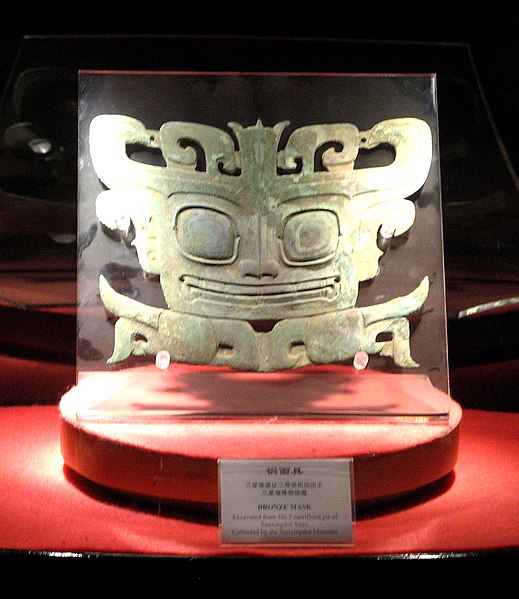
Bronze Plaque of a Taotie Face
Sanxingdui Museum

|
Bronze Plaque of a Taotie FaceSanxingdui Museum |
This thin plaque, about 21cm (8in) tall, is one of nine similar objects in the museum. The downward curve at the corners of its mouth is a typical feature of Sanxingdui style, so that the plaque was probably cast in Sanxingdui; i.e. it is an imitation of an import, rather than an import itself. The English-language museum label inscrutably identifies it as a "one-legged monster," so let's try to decode this. First of all, the word "monster" in this case means taotie, an imaginary face that is ubiquitous in Chinese Bronze Age art. We'll come back to the "one-legged" idea in a moment.
Parts of the Taotie
Mastering this design vocabulary, however strange it may appear at first, will help the viewer to appreciate the decoration on uncounted numbers of ancient Chinese bronzes and other artifacts.
Using this plaque as an example, three horn-like projections run across the top of the face. The outermost "horn" is actually the tail of the "monster!" Next to it, there is another "horn" with two curls on either side of an upright stalk. This is the actual horn. Finally, there is an upright projection above the center of the face that represents a tuft of hair or a crest. Below this, the face's eyes, nose, ears, and mouth are all recognizable and appear in their proper places. However, on other taotie, they can become so abstract as to be hard to recognize. They may also be separated from each other, as pure decoration, on the body of a vessel.
Back to our example. The horizontal appendages below its chin resemble crab claws; actually, though, in the design vocabulary of Shang bronzes, they are stylized eyes (yes, these are in addition to the regular eyes on the face. They are just design elements, not real eyes, at this point.) The round element is the iris (colored part) of the eye, and the hooks on either side of this are a distorted version of the sclera, the "white of the eye." Below the eye is a dangling element that represents a leg, bent at the knee.
To understand why this is called a "one-legged" monster, imagine that the generic taotie face (not this actual plaque) is bent at a right angle along the midline of the face, for example on the corner of a square vessel. Then it would be two faces, each in side view, meeting at the corner. Each side of the taotie is actually a different creature, with its own leg (one), tail (one), eye (one), etc. This is sometimes described as "a side view extended for reasons of symmetry." That doesn't contradict the explanation given above, since the face is indeed symmetrical. Two side views joining at a corner, which can be seen on hundreds of actual examples, explains where this symmetry comes from.

|

|

|